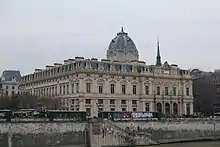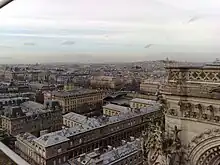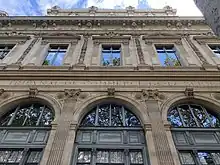


The Tribunal de commerce de Paris ("Paris commercial court[house]"), until 1968 Tribunal de commerce de la Seine, refers both to the tribunal de commerce of Paris, a commercial court, and to the building that hosts it on the Île de la Cité in Paris. Because that building's main entrance is on the quai de la Corse, the phrase Quai de la Corse is used as a nickname for the court, not least with reference to its role in corporate insolvencies.[1]
Court
The Tribunal de commerce de Paris traces its roots to the commercial court or tribunal des juges et des consuls de Paris, created in 1563 by Chancellor Michel de l'Hôpital. Like other such institutions, it was renamed tribunal de commerce in August 1790 during the French Revolution. Aside from the first few years at Abbaye Saint-Magloire de Paris, the court was located on Rue du Cloître-Saint-Merri next to the Church of Saint Merri from 1570 to 1826. In 1826, it moved to the newly built Palais Brongniart, also home of the Paris Bourse.[2] From 1790 to 1968 it was the Tribunal de commerce de la Seine, and took its current name with the dismantling of the Seine Department in 1968.
Building
In 1857, the Conseil général de la Seine decided the construction of a new building for the Tribunal de Commerce and the conseil des prud'hommes, which later moved to a separate location. Part of the grounds that were reserved for it had been the location of the ancient Church of Saint-Barthélemy. Following its demolition in 1791, the church had been replaced by entertainment venues, first the Théâtre de la Cité-Variétés and then the Prado ballroom. That building and nearby houses, in turn, were demolished in 1858 for the complete remodeling of the middle section of the Île de la Cité, a major project of Haussmann's renovation of Paris.
The courthouse building for the Tribunal de Commerce was built between 1859 and 1865 on a design by architect Antoine-Nicolas Bailly, inspired by the Renaissance Palazzo della Loggia in Brescia. It was ceremoniously inaugurated by Napoleon III on 26 December 1865,[3] and the court's first hearing was held the next day.[2] In the 1930s, it underwent a remodeling that transformed the atrium's ceiling and lower parts of the northern façade, but has otherwise been largely preserved in its original state.[2]
The main entrance, on the Quai de la Corse, is decorated with statues of Law by Élias Robert, Justice by Jacques-Hyacinthe Chevalier, Firmness by Louis-Adolphe Eude, and Prudence by Jules Salmson.[3] Above these is a decorated pediment supported by four figures sculpted by Albert-Ernest Carrier-Belleuse. The ornate octagonal dome rises to a height of 45 meters and is the building's most distinctive exterior feature. It is positioned to close the perspective of the Boulevard de Sébastopol, and as a consequence, is not aligned with the center of the building's façade.
The interior is organized around two monumental spaces: to the east, a columned atrium (French: salle des pas-perdus), and to the west, a monumental staircase under the building's dome, entered through a vestibule decorated by a pair of monumental lions sculpted by Pierre Louis Rouillard. The staircase is decorated with colossal statues representing Maritime Commerce, by Henri Chapu; Land Commerce, by Paul Cabet; Mechanical Art, by Hippolyte Maindron; and Industrial Art, by Michel-Pascal. Above these are 16 caryatids by sculptor Didier Début, and the dome's ceiling with representations of the City of Paris, Arts, the City of Marseille, Grain harvest, the City of Lyon, Industry, the City of Bordeaux, and Grape-harvest, by Armand Félix Marie Jobbé-Duval.[4] On the first floor, the main hearing room (French: grande salle d'audience) is decorated with busts of the court's founder Michel de l'Hôpital and of Jean-Baptiste Colbert, author of the ordonnance sur le commerce of 1673, and with historical paintings by Paul-Louis Delance and Joseph-Nicolas Robert-Fleury.[4]
Gallery
 View in the mid-1860s, by Charles Marville
View in the mid-1860s, by Charles Marville Atrium with bust of Michel de l'Hôpital
Atrium with bust of Michel de l'Hôpital Monumental staircase
Monumental staircase Grande salle d'audience
Grande salle d'audience Grande salle d'audience, detail of ceiling
Grande salle d'audience, detail of ceiling Chambre du Conseil
Chambre du Conseil Bureau du Président
Bureau du Président Detail of exterior decoration
Detail of exterior decoration
See also
Notes
- ↑ Jean-Baptiste Jacquin (28 August 1997). "Rififi au tribunal de commerce de Paris". L'Express.
- 1 2 3 "L'histoire des Tribunaux de Commerce". Tribunal de Commerce de Paris.
- 1 2 "Le Tribunal de Commerce - Paris 4e". Paris 1900.
- 1 2 "L'histoire et le patrimoine : Le patrimoine du Tribunal de Commerce de Paris". Tribunal de Commerce de Paris.